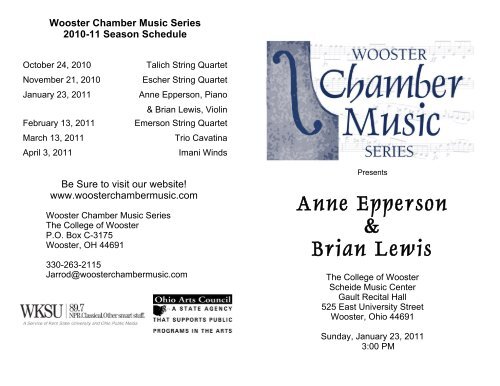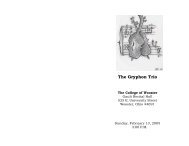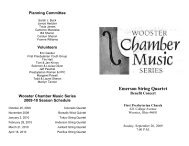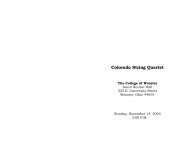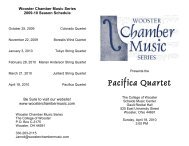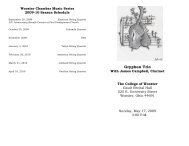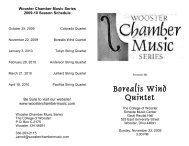Anne Epperson & Brian Lewis - Wooster Chamber Music Series
Anne Epperson & Brian Lewis - Wooster Chamber Music Series
Anne Epperson & Brian Lewis - Wooster Chamber Music Series
You also want an ePaper? Increase the reach of your titles
YUMPU automatically turns print PDFs into web optimized ePapers that Google loves.
<strong>Wooster</strong> <strong>Chamber</strong> <strong>Music</strong> <strong>Series</strong><br />
2010-11 Season Schedule<br />
October 24, 2010<br />
November 21, 2010<br />
January 23, 2011<br />
February 13, 2011<br />
March 13, 2011<br />
April 3, 2011<br />
Talich String Quartet<br />
Escher String Quartet<br />
<strong>Anne</strong> <strong>Epperson</strong>, Piano<br />
& <strong>Brian</strong> <strong>Lewis</strong>, Violin<br />
Emerson String Quartet<br />
Trio Cavatina<br />
Imani Winds<br />
Be Sure to visit our website!<br />
www.woosterchambermusic.com<br />
<strong>Wooster</strong> <strong>Chamber</strong> <strong>Music</strong> <strong>Series</strong><br />
The College of <strong>Wooster</strong><br />
P.O. Box C-3175<br />
<strong>Wooster</strong>, OH 44691<br />
330-263-2115<br />
Jarrod@woosterchambermusic.com<br />
Presents<br />
<strong>Anne</strong> <strong>Epperson</strong><br />
&<br />
<strong>Brian</strong> <strong>Lewis</strong><br />
The College of <strong>Wooster</strong><br />
Scheide <strong>Music</strong> Center<br />
Gault Recital Hall<br />
525 East University Street<br />
<strong>Wooster</strong>, Ohio 44691<br />
Sunday, January 23, 2011<br />
3:00 PM
A Message to Our Friends<br />
As we begin our 26 th year together, we are aware of how fortunate<br />
we have been to have you, our special audience, as our friends<br />
and supporters. We have worked diligently to continue to bring<br />
you the quality programming to which you have become<br />
accustomed. You will note that we are bringing back some old<br />
friends—the Talich and Emerson quartets, and <strong>Anne</strong> <strong>Epperson</strong><br />
among them; we have heeded the numerous requests to host the<br />
Imani Winds again; and we will introduce you to two brand new<br />
groups to our series—the Escher String Quartet, and the recent<br />
Naumberg winners, the Trio Cavatina.<br />
We know you will enjoy our season.<br />
This year, we have increased our outreach opportunities for<br />
children, since we are mindful of the impact of early exposure to<br />
this music. We are committed to bringing only world class<br />
ensembles as a part of the <strong>Wooster</strong> <strong>Chamber</strong> <strong>Music</strong> <strong>Series</strong>,<br />
because we know that’s what you deserve. We want to share this<br />
music with you, and we encourage you to share these experiences<br />
by bringing your friends to the concerts.<br />
We are happy to welcome you to another great season.<br />
Remember to join us and the musicians after each concert for our<br />
reception in the lobby.<br />
Cheers,<br />
Yvonne C. Williams<br />
Artistic Director<br />
Advisory Committee<br />
Sarah J. Buck<br />
Jarrod Hartzler<br />
Tricia James<br />
Jay Klemme<br />
Cameron Maneese<br />
Cyril Ofori<br />
Bill & Carolyn Sheron<br />
Jill Henley Shafer<br />
Yvonne Williams<br />
Tom Wood<br />
Sarah Jane Buck and<br />
Nick Amster Fishelson<br />
Julia Fishelson<br />
Stanley & Flo Gault<br />
Ralph Jones<br />
Jay Klemme and <strong>Anne</strong> Wilson<br />
Ed and Mary Eberhart<br />
Clara Louise Patton<br />
David & Carol Briggs<br />
Dorothy Carlisle<br />
Mary Grace Collinge<br />
Mildred Froelich<br />
Com-Patt-ibles Floral Elegance<br />
<strong>Brian</strong> & Karen Gardener<br />
Catherine and Tom Graves<br />
Louise E. Hamel<br />
Elinor Hancock<br />
Ken & Nancy Anderson<br />
Bill & Marilyn Blanchard<br />
Thomas Bruch<br />
Grant & Peg Cornwell<br />
Marian Taylor Cropp<br />
Polly & Denny Davis<br />
Richard & Susan Figge<br />
Larry Gabriel<br />
Liz & Steve Glick<br />
Lucille L. Hastings<br />
Gennie & J.C. Johnston<br />
Frank & Jean Knorr<br />
Rhoe & Elizabeth Benson<br />
Bert Bishop<br />
Joe & Dee Durbin<br />
Jack & April Gallagher<br />
Martha Hancock<br />
Thank You<br />
UNDERWRITER<br />
BENEFACTOR<br />
PATRON<br />
SUBSCRIBER<br />
FRIENDS<br />
The Donald and Alice Noble Foundation<br />
Cyril and Amelia Ofori<br />
Kenneth E Shafer<br />
Jill Henley Shafer<br />
Tim & Jenny Smucker<br />
Yvonne C. Williams<br />
Bill and Carolyn Sheron<br />
Frances G. Shoolroy<br />
Peter and Tricia James<br />
Terry Wagner Ling<br />
Sara L. Patton<br />
Kenneth & Louise Plusquellec<br />
Margaret & David Powell<br />
Ed Schrader and Dan Rider<br />
Mary Alice Streeter<br />
Marilyn Tanner<br />
Kathy and Harry Zink<br />
Beth & Arn <strong>Lewis</strong><br />
Lyn Loveless<br />
Julie Mennes<br />
Jon & Pam Rose<br />
Steve & Cheryl Shapiro<br />
Mike & Maxine Smith<br />
Derek Somogy<br />
Peggy and Charles Ulrich<br />
Mina and Don Van Cleef<br />
Carol Rueger and David Wiesenberg<br />
Ron Williams<br />
Ned & Jean Woolums<br />
Frank & Barbara Hays<br />
Cally King<br />
Roberta Looney<br />
Steve & Sandy Nichols<br />
Elena Sokal & Yuri Popov
Sonata in B-flat Major, K. 454<br />
W.A. Mozart<br />
This sonata was written for a violin virtuoso, to be performed together with the<br />
composer at a concert in the Kärntnerthor Theater in Vienna on April 29, 1784.<br />
Although Mozart had the piano part securely in his head, he did not give himself<br />
enough time to write it out, and thus performed it with a sheet of blank music<br />
paper in front of him. According to a story told by his widow Constanze Mozart,<br />
the Emperor Joseph II saw the empty sheet music through his opera glasses<br />
and sent for the composer with his manuscript, during which time Mozart had to<br />
confess the truth.<br />
The sonata opens with an exceptionally slow introduction, in which emphasis is<br />
put on the equality of the two instruments, kept throughout the entire work. The<br />
second movement has a melodic feeling of adagio, which was the tempo written<br />
down by Mozart at first, but then crossed out and marked Andante. In the<br />
development section there are bold chromatic modulations. The final movement<br />
returns to the playful mood of the first, but even so happens to be a very<br />
sophisticated Rondo.<br />
Salut d’amour<br />
Edward Elgar<br />
In the summer of 1888, Edward Elgar and Alice Roberts were heading towards<br />
marriage. Edward decided on a holiday with a long-time friend. As he left, Alice<br />
presented Edward with a poem she had written and entitled Love's Grace. While<br />
on holiday, Edward reciprocated by writing a short piece of music for her, which<br />
he called Liebesgruss (Love's Greeting). On his return, Elgar presented the work<br />
to Alice and proposed to her. They married in May of the following year.<br />
Towards the end of 1888, Edward submitted three arrangements of the work, for<br />
solo piano, for violin and piano, and an orchestral arrangement, to a music<br />
publishing firm. Apparently with Elgar's approval, the firm retitled the work Salut<br />
d'amour and gave the composer's name as Ed. Elgar, believing that the French<br />
title and a less obviously English composer would help the work gain wider<br />
international approval.<br />
Rumanian Folk Dances<br />
Béla Bartók<br />
The Rumanian Folk Dances are based on folksongs and dances collected by<br />
Bartók from peasants and Gypsies during his pioneering ethno-musicological<br />
field trips through Hungary in 1910-14. The first dance, which translates into<br />
English as "dance with a staff," is from the Maros-Torda region. Bartók reported<br />
that it was played to him by two Rumanian Gypsy violinists from Màramaros.<br />
The Bràul is a dance that involves the use of a waistband or sash. The lovely<br />
third dance, in which the violin imitates the sound of a rustic flute, while the<br />
piano acts as a drone, translates roughly into "the Stomper." Both of these<br />
dances are from Torontàl. Another lovely melody is presented in The Dance of<br />
the Buscum People from Torda-Aranyos. Next we have a Rumanian "Polka"<br />
from Bihar. Finally, the last movement is made up of two fast dances.<br />
-- Jarrod Hartzler<br />
Tempo di Minuetto<br />
<strong>Anne</strong> <strong>Epperson</strong> & <strong>Brian</strong> <strong>Lewis</strong><br />
<strong>Anne</strong> <strong>Epperson</strong>, Piano<br />
<strong>Brian</strong> <strong>Lewis</strong>, Violin<br />
Program<br />
Sonata in A Major<br />
Allegretto moderato<br />
Allegro<br />
Recitativo-Fantasia; Moderato<br />
Allegretto poco mosso<br />
Sonata in B-flat Major, K. 454<br />
Largo – Allegro<br />
Andante<br />
Allegretto<br />
Salut d’amour<br />
Syncopation<br />
Rumanian Folk Dances<br />
Joc Cu Bata<br />
Bràul<br />
Pe Loc<br />
Buciumeana<br />
Poarca Romaneasca<br />
Maruntel<br />
Intermission<br />
Fritz Kreisler<br />
César Franck<br />
W.A. Mozart<br />
Edward Elgar<br />
Fritz Kreisler<br />
Béla Bartók<br />
** Please join us after the concert for a reception in the Scheide <strong>Music</strong><br />
Center lobby.
Biography<br />
<strong>Anne</strong> <strong>Epperson</strong> is a brilliant collaborative pianist, noted for her extraordinary<br />
musicality, sensitivity, and technical expertise. She performs with other<br />
distinguished artists worldwide, appearing throughout North and South America,<br />
Europe, Israel, Scandinavia, Taiwan, and Korea. Ms. <strong>Epperson</strong> is well-known to<br />
the <strong>Wooster</strong> audience, having performed here numerous times since the<br />
earliest years of our <strong>Chamber</strong> <strong>Music</strong> <strong>Series</strong>. She made her debut with the New<br />
Orleans Philharmonic at age twelve, and later studied at Louisiana State<br />
University and the Juilliard School. While in graduate school at the University of<br />
Southern California, she served as staff pianist for the master classes of Jascha<br />
Heifetz, which helped launch her remarkable collaborative career. In this vein,<br />
she has done much to transform the role of accompanist to collaborative pianist,<br />
whereby the pianist is an equal partner (rather than secondary) with the other<br />
performers. Emphasis is placed on the cooperative relationship and interplay<br />
between the musicians, resulting in an overall elevation in the quality and depth<br />
of the music.<br />
<strong>Anne</strong> <strong>Epperson</strong> has created Collaborative Piano programs at several<br />
universities. In 2008, she inaugurated the new Collaborative Piano Department<br />
at the University of Texas at Austin, where she currently teaches. She<br />
developed a new graduate degree program at the University of Colorado at<br />
Boulder, where she was Professor from 2004 to 2008. From 2001 to 2004 she<br />
was Professor of <strong>Music</strong> and Director of Collaborative Arts at the University of<br />
California - Santa Barbara, and prior to this she spent 16 years as head of the<br />
Collaborative Piano Department, which she created, at the Cleveland Institute of<br />
<strong>Music</strong>. She has acted as consultant and advisor in the development of<br />
collaborative piano programs worldwide. Ms. <strong>Epperson</strong> has been a jury member<br />
for many prestigious competitions, as well as panelist, lecturer and master class<br />
presenter for music teacher associations nationwide. She has been guest<br />
performer and coach at many music festivals around the country. <strong>Anne</strong><br />
<strong>Epperson</strong> has made recordings for Vanguard, <strong>Music</strong>al Heritage Society,<br />
Nonesuch, Centaur, Koch International, Claves, and Azica.<br />
Violinist <strong>Brian</strong> <strong>Lewis</strong> has impressed critics and audiences alike with his<br />
exceptional virtuosity, charisma, and versatility. He has made concerto debuts<br />
at both Carnegie Hall and Avery Fisher Hall, and has performed with numerous<br />
orchestras in North America, Europe, and Asia. Mr. <strong>Lewis</strong> has appeared as<br />
recitalist at venues across the United States, including Lincoln Center’s Mostly<br />
Mozart Festival and Great Performers <strong>Series</strong>, as well as appearing on stages<br />
throughout the world. He has won awards that include the Waldo Mayo Talent<br />
Award, Juilliard’s Peter Mennin Prize and William Schuman Prize, and the Sony<br />
ES Award for <strong>Music</strong>al Excellence. He recently received the Medal of St.<br />
Barthélemy, for his 19 years of artistic service to St. Barths (in the French West<br />
Indies), where he has acted as concertmaster and soloist at the St. Barths<br />
<strong>Music</strong> Festival.<br />
<strong>Brian</strong> <strong>Lewis</strong> began his study of the violin at age four, in the Ottawa Suzuki<br />
Strings program. He later traveled twice to Matsumoto, Japan in order to study<br />
with Dr. Shinichi Suzuki, founder of the well-known Suzuki Method. He was a<br />
student of Dorothy DeLay, Masao Kawasaki, and Hyo Kang at the Juilliard<br />
School, where he earned both the Bachelor and Master of <strong>Music</strong> degrees.<br />
Mr. <strong>Lewis</strong> is committed to the education of young artists, and has frequently<br />
presented concerts, workshops, and master classes to Young Audiences of<br />
Houston. For these activities, he was named National Artist of the Year in 1998,<br />
and received the Fredell Lack Award in 2003.<br />
Mr. <strong>Lewis</strong> is Professor of Violin at the University of Texas. He is also Artistic<br />
Director of the Starling-Delay Symposium on Violin Studies at the Juilliard<br />
School, Concertmaster of the River Oaks <strong>Chamber</strong> Orchestra in Houston,<br />
Artistic Director of the <strong>Brian</strong> <strong>Lewis</strong> Young Artists Program in Kansas, a founding<br />
member of the Texas Piano Quartet, and Artistic Director of the Starling<br />
Distinguished Violinist <strong>Series</strong> at the Butler School of <strong>Music</strong>. He is currently in the<br />
midst of a year-long Visiting Professor residency at the Yale School of <strong>Music</strong>.<br />
-- Sarah J. Buck<br />
Program Notes<br />
Tempo di Minuetto, Syncopation<br />
Fritz Kreisler<br />
Fritz Kreisler was an Austrian violinist and composer known for his original<br />
compositions and transcriptions for violin and piano. His works are often<br />
identified as having a distinctly Viennese flavor, and can be at turns charming,<br />
melancholic or majestic. His talent as a composer was matched by his playing<br />
abilities and his performances of his own works rank as some of the greatest<br />
recordings ever made.<br />
Tempo di Minuetto was originally attributed to Gaetano Pugnani, first violinist of<br />
the King’s <strong>Music</strong> in Turin. However, Kreisler later amended the title page of this<br />
to “in the style of” Pugnani. This is a stately Minuet that exudes the poise and<br />
pride of Imperial Vienna.<br />
As Kreisler climbed the ladder to the position of a leading virtuoso, he felt that<br />
the violinist's repertoire was limited in scope and variety so he began to compose<br />
pieces in different styles to use in his own concerts. These pieces took the form<br />
of arrangements and transcriptions. Syncopation is among these.<br />
Sonata in A Major<br />
César Franck<br />
Franck’s compositional style favors frequent modulations as he develops the<br />
initial melodic material throughout the piece. He promised Wagner’s wife,<br />
Cosima, a violin sonata in 1859, but put it off. Finally, the famed Ysaÿe, a fellow<br />
Belgian, persuaded Franck to write a violin sonata in honor of Ysaÿe’s wedding.<br />
The 1886 premiere took place in an art gallery in Brussels.<br />
The opening movement is in sonata form, but leaves out the development<br />
section, to avoid conflict. It is harmonious and reflective. The piece develops less<br />
by thematic opposition than by a gradual rising and falling of tension. It uses<br />
what Franck referred to as “cyclic” development: all the movements share<br />
common thematic threads. The second movement is turbulent, but subsides to a<br />
foreboding calm. The third movement is somewhat amorphous; Franck called it a<br />
“recitative-fantasia.” The Finale opens with a sunny theme. There is a<br />
recapitulation of sorts, and the ending is a fervent proclamation of love for the<br />
married couple.


